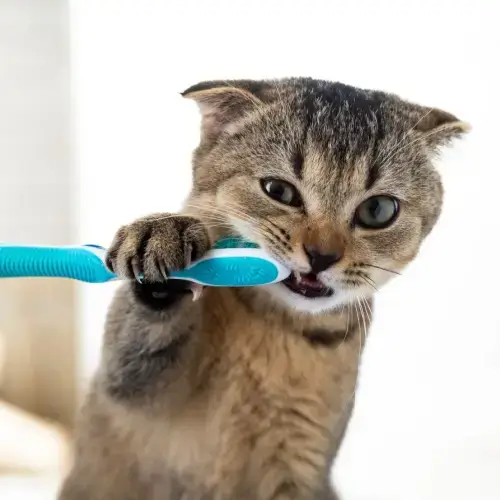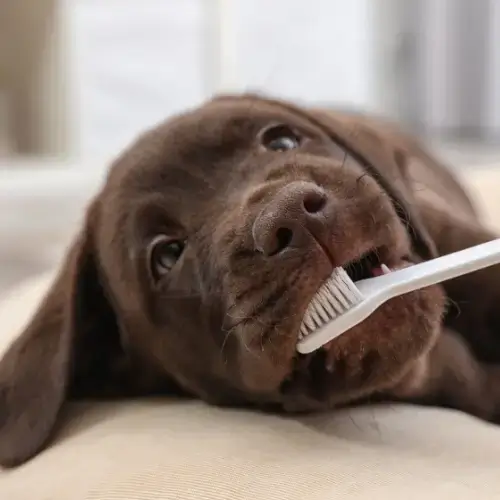Home / Compare Pet Insurance / Pet insurance that cover…




Key takeaways
- Pet insurance typically covers dental care related to accidents (e.g. broken teeth from injuries) but often excludes routine dental care like cleaning.
- Dental issues that existed before purchasing the policy are generally not covered, and there may be waiting periods before dental treatments are eligible for cover.
- Regular dental maintenance, such as brushing your pet’s teeth, can help reduce the need for expensive dental treatments. Routine dental care is an optional extra you can add to some pet insurance policies to cover these treatments.
How does pet insurance work?
Pet insurance in Australia can help cover the cost of veterinary care for accidents, illnesses, and sometimes services to maintain your pet’s overall health and well-being, like vaccinations and dental care.
You pay a monthly premium, and in return, the insurer reimburses you for eligible expenses, typically covering 70% to 90% of your vet bills. However, you’ll usually need to pay the whole bill upfront and then submit a claim for reimbursement.
Dental care may be included, but this depends on your policy and the reason for the treatment. While accidental injuries are often covered, dental issues related to things like illness may have limitations or exclusions. Optional extras such as routine care can be added to some policies to provide more comprehensive cover for your furry friend.
Many pet insurance plans have annual benefit limits, which could impact the total amount you can claim in a year. There may also be sub-limits depending on the insurance policy. Please review the policy’s details to ensure it meets your pet’s needs. Always read your Product Disclosure Statement (PDS) and the Target Market Determination (TMD) to understand what is and is not covered in your policy and whether the policy is right for your pet.
Does pet insurance cover dental care?
Is dental cover a standard inclusion?
 While pet insurance can cover many medical conditions, dental cover is typically not included in standard policies in Australia. However, some more comprehensive plans may offer dental coverage as an optional add-on.
While pet insurance can cover many medical conditions, dental cover is typically not included in standard policies in Australia. However, some more comprehensive plans may offer dental coverage as an optional add-on.
It’s important to note that there may be waiting periods before you can claim dental treatments, typically between 6 months and 2 years. Additionally, policies may have exclusions, benefit limits, and excess payments. Always check your benefit limits to ensure your policy covers the treatments your pet may need.
Cover varies by policy, but some common dental issues that could be covered include:
- Gingivitis: A gum disease that causes irritation, swelling, and redness around the base of the teeth.
- Abscesses: Infections or pus-filled pockets in the mouth or around the roots of the teeth, often caused by infection or injury.
- Tooth extraction: The medically necessary removal of your dog’s teeth due to dental disease, infections, cavities, fractures, or retained baby teeth.
- Jaw fractures and associated repairs: Cover for injuries to the jawbone and necessary surgical repairs after trauma or accidents.
- Fractured teeth repair: Treatment for tooth fractures or broken teeth due to accidents or dental issues may require dental crowns or other repair methods.
- Periodontal disease: A severe gum infection caused by plaque buildup that can damage the gums and teeth.
- Tooth resorption: The breakdown and absorption of teeth, particularly common in cats.
- Dental trauma: Injuries to the teeth or mouth caused by accidents or trauma.
Many insurance companies have exclusions regarding dental care, such as cover for pre-existing conditions, cosmetic procedures, orthodontics, and non-medically necessary treatments. Additionally, some insurance policies may exclude dental illnesses like periodontal disease or abscesses, particularly if the condition could have been prevented with better home dental hygiene. However, these exclusions can often be addressed by purchasing routine care as an add-on, which may cover services like teeth cleaning and other specified dental conditions.
Always review your policy’s details to confirm which dental treatments are included and whether additional cover is available.
Is routine dental care included?
Pet insurance policies often exclude routine dental care, such as regular cleanings and checkups. While some pet insurance providers may offer optional extra or preventive care add-ons that could cover routine dental treatments, these are generally not included in standard policies.
Since pet insurance is designed primarily to cover unexpected accidents or illnesses, most policies offer add-ons for preventive dental treatments, such as:
- Teeth cleaning (unless medically necessary)
- Dental checkups
- Teeth brushing
Most routine care optional extras have annual sub-limits based on different categories, so always read your Product Disclosure Statement (PDS) to understand your cover and sub-limits. Read the Target Market Determination (TMD) to help you decide whether an insurance product is the right fit for you and your pet.
Common exclusions and limitations in pet dental insurance
Pre-existing conditions
Most pet insurance products will not cover any health problems or dental issues that existed before the start of your policy. This is particularly relevant for pets with periodontal disease, tooth damage, or other dental concerns before getting insured.
Waiting periods
Many pet insurance policies impose a waiting period before certain types of care are covered. This applies to dental treatments as well. For example, if your pet’s dental care needs arise shortly after enrolling in a policy, the insurance provider might not cover the cost until the waiting period has passed.
Cosmetic procedures
Cosmetic surgery to alter the natural appearance of animals, such as tail docking and ear cropping, is not covered in any pet insurance policy and is also illegal in Australia.1 If pet dental care, such as teeth whitening, is deemed cosmetic or unnecessary for health, it is often excluded from cover.
Age limits
Some policies may have age limits for dental cover. Older pets might face higher premiums or exclusions for dental care due to the increased likelihood of pre-existing conditions or age-related dental issues.
How to maintain your pet’s dental health
 While pet insurance can help with the financial burden of dental treatment, maintaining your pet’s oral health is the best way to prevent costly dental issues in the first place. Here are a few tips to help you maintain your pet’s dental health:
While pet insurance can help with the financial burden of dental treatment, maintaining your pet’s oral health is the best way to prevent costly dental issues in the first place. Here are a few tips to help you maintain your pet’s dental health:
- Brushing your pet’s teeth: Brushing your pet’s teeth regularly using a toothbrush and pet toothpaste can significantly reduce the buildup of plaque and tartar.
- Dental treats and toys: Providing your pet with dental chews or toys can help maintain oral hygiene and prevent dental disease.
- Regular vet checkups: Regular dental checkups with your veterinarian can help spot issues before they become serious, reducing the likelihood of expensive dental procedures.
- Professional cleanings: Some vets offer professional cleanings as part of a wellness plan, so check if this is included in your pet insurance add-on.
How can I tell if my pet has dental issues?
It’s not always easy to tell when your pet is experiencing dental problems since they can’t verbally communicate their discomfort. If you notice any of the following symptoms, it’s important to consult your veterinarian. Early detection of dental issues can prevent more severe conditions, reduce pain, and avoid costly treatments. Regular dental checkups are crucial for maintaining your pet’s oral health and catching potential problems before they worsen.
Here are several signs you can watch for to determine if your pet might be suffering from dental issues:
- Bad breath (Halitosis): If your pet’s breath has a strong, foul odour that doesn’t go away, it may indicate the presence of plaque, tartar or gum disease. Bad breath is often one of the earliest signs of dental problems.
- Changes in eating habits: If your pet begins to avoid hard food, chew on one side of their mouth, or seems to have difficulty chewing or swallowing, it could be due to dental pain or tooth sensitivity.
- Excessive drooling: If your pet is drooling more than usual, especially if it is tinged with blood, it could be a sign of an infection or gum disease.
- Swollen or bleeding gums: Gum inflammation, swelling, redness, or bleeding around the teeth is often a clear sign of dental issues, such as gingivitis or periodontal disease.
- Visible tartar or plaque: If you notice yellow or brown buildup on your pet’s teeth, this could be tartar or plaque contributing to gum disease and tooth decay.
- Changes in behaviour: Pets with dental pain may become irritable, less active, or shy away from being touched near the mouth. They may also start pawing at their face or mouth.
- Loose or missing teeth: If your pet’s teeth appear loose or if you notice a missing tooth, it could be a sign of advanced periodontal disease or trauma to the mouth.
- Mouth sensitivity: If your pet flinches when its face or mouth is touched, it could indicate pain associated with dental issues such as an abscess, infected tooth, or severe gum disease.
If you notice any of these symptoms, it’s important to consult your veterinarian. Early detection of dental issues can reduce pain, prevent more severe conditions, and avoid costly treatments. Regular dental checkups are crucial for maintaining your pet’s oral health and catching potential problems before they worsen.
Meet our pet insurance expert, Adrian Taylor
As a General Insurance expert with over 13 years’ experience in financial services, Adrian Taylor knows that dogs and cats get themselves into all sorts of mischief. One part of Adrian’s work is to help empower consumers to understand how pet insurance can help save them from exorbitant vet bills when their pet gets injured or falls ill.
Want to know more about pet insurance?
1Australian Veterinary Association (AVA). Cosmetic surgery to alter the natural appearance of animals. Accessed December 2024.

